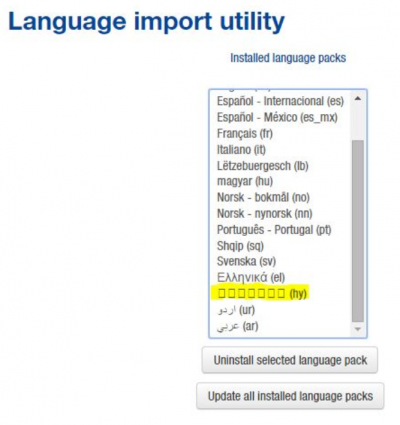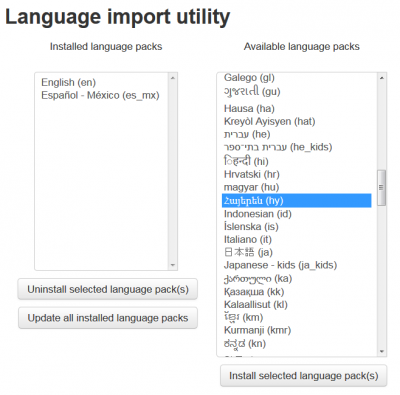- Language settings
- Language customization
- Language FAQ
Contents
1.1 Which is the official language of LMS?
1.2 What do codes like “en” and “en_us” or “es” and “es_mx” and “es_ve” mean??
2.1 Where can I set the default language for the site?
2.2 When I change to a new default language, users still have the old language.
2.3 When I log in, the language switches to English. Why?
2.4 I’ve set a default site language, but the LMS calendar is in English. Why?
2.5 How can I disable (hide) the language drop-down menu on the site front page?
3 Language Customisation and Multi-language
3.1 How can I change a word or phrase used in LMS?
3.2 How can I find where a language string is located?
3.3 Why are my changes not saved in my LMSCloud site?
3.4 Why are my changes not saved if I edit a language pack with the LMS language pack editor?
3.5 How can I provide course content in more than one language?
3.6 How can I provide course headings in more than one language?
3.7 Are there any shortcuts for editing a language?
3.8 Is it possible to customize language strings per theme?
5.1 Will installing several language packs decrease my server performance?
5.2 What is this Pirate version of English doing on my site?
5.3 Lang pack download failed with ‘HTTP response code: HTTP/1.1 404 Not Found’ after a new release
5.4 Why do the characters for my language (not English) show up as hollow squares?
5.5 Are there statistics for language packs downloads?
5.6 Is it possible to streamline the translation of an LMS course?
-
General
Which is the official language for LMS?
The “official” language for LMS is actually the Australian English (hey mate!), which is 100% the same as UK English. The default language on a new installation of LMS, unless you change it, will be this version of English, denoted by the language code “en”.
What do codes like “en” and “en_us” or “es” and “es_mx” and “es_ve” mean??
These are the language codes for each language. There is a standard for these, see ISO language code list.
The second part, “_us” or “_mx” and “_ve” for example, represent localisations of the main language for a particular country or dialect. Typically these will include variant spellings and other preferred local terminology and phrasing. So “es_mx” has spellings and idioms (and a very important Decimal separator) used in Mexican Spanish which are distinct from international Spanish. The es_ve has small differences from the international Spanish that are of significance to LMS users in Venezuela.
“en_us” is the English – United States language pack; “en” is Australian English, which is practically the same as British English.
I found a mistake or typo in a language pack. Or my language is only partial, much of it is still English. What do I do?
Language packs have maintainers and LMS has its own language translation toolkit, known as AMOS. Other than some core languages maintained by LMS HQ, most languages are maintained by volunteer maintainers.
Default Language
Where can I set the default language for the site?
Site Administration > Language > Language settings
Note you can only choose to set as default a Language pack that is already installed. If the language you want is not on the list, you will need to install the language pack first.
When I change to a new default language, users still have the old language.
Correct. When you change to a new site default language, this does not update the language setting in the profile for already existing users. It only sets a new default for new user accounts you create from now on.
To do updates for already existing users, you can:
- Tell users how to change it themselves in their user profiles by setting their Preferences > Preferred language
- Use the Upload users tool to do a mass update from a csv file changing the lang field
- If you have access to the database, you can change this with a simple query.
When I log in, the language switches to English. Why?
- For logged-in users, the language is set to the one they have set as their preferred language (Preferences > User account > Preferred language).
- For logged-out visitors (before they log in) the situation depends on whether the language auto-detection is enabled. They can either get the language their browser claims to be the requested one, or the site default language.
I’ve set a default site language, but the LMS calendar is in English. Why?
If your LMS calendar is not translated, then the string ‘locale’ (for *nix servers) or the string ‘localewin’ (for Windows servers) in the ‘langconfig.php’ file is wrong (or your server is not configured to support the language). There are quite a few languages that are not supported by Windows servers and the localewin server cannot be set. In that case, you have to run your LMS on a *nix server to make the translation of your LMS calendar work.
Go to Site administration > Language > Language settings and un-tick the ‘Display language menu’ checkbox.
Because it is a customization, LMS will not erase the xx_local language files in LMSdata with an upgrade. LMS will upgrade any language folders it finds in the lms/lang folder.
Language Customisation and Multi-language
How can I change a word or phrase used in LMS?
In Administration > Site Administration > Language > Language customisation.
See Language customization for details.
How can I find where a language string is located?
See the section ‘Finding the component and string identifier’ in Language customization.
Why are my changes not saved in my LMSCloud site?
Unfortunately customizing language strings is not supported in LMSCloud. (The same string cache is used for all sites and is read-only.)
Why are my changes not saved if I edit a language pack with the LMS language pack editor?
This could be caused by the caching on the server. Language strings are cached into server memory for performance reasons and when you save changes, they may not be immediately picked up. First, refresh your own browser cache to refresh the pages from the site. Then if the strings are still not there, an administrator can purge the cache of the server.
How can I provide course content in more than one language?
Labels, web pages, activity descriptions etc. may be provided in more than one language using the Multi-language content filter.
Another option is to create activities in different languages and restrict access to them using the Restriction by language plugin.
How can I provide course headings in more than one language?
Set the multi-language content filter to apply to content AND headings in Site administration > Plugins > Filters > Manage filters.
Are there any shortcuts for editing a language?
Yes, but be careful. You can make use of the customize language process. Basically,y copy the PHP files that contain the strings you want to change to the lmsdata/lang/local folder. For example, copy the /lang/en/lms.php file to someplace. Edit the file with a search and replace with whole word and case sensitive turned on, change Teacher to Instructor and Teachers to Instructors, do the same for teacher and teachers. Now copy that saved copy of the lms.php file to the lmsdata/lang/en_local folder. Be careful not to change the String name.
Is it possible to customize language strings per theme?
Not by default, as when strings are customized, they are customized for the whole site. However, it is possible to make a new language pack based on your main language and apply that pack to the course which has the theme.
Is it possible to change the logo according to the language selected, similar to multi-language content?
Yes.
Other Language Questions
Will installing several language packs decrease my server performance?
Installing many (20+) language packs have almost 0 impacts on LMS performance. A copy of the language packs installed is stored in your site’s local /lmsdata directory. Also, actively used language strings are cached in memory by your server as well to help performance, so as long as your server has sufficient RAM there will be no impact from having many language packs installed.
What is this Pirate version of English doing on my site?
It has become something of a custom in the LMS community over the years to observe ‘Talk Like a Pirate Day’ (September 19th) by temporarily changing the language of a site to allow the English – Pirate (en_ar) language pack.
Lang pack download failed with ‘HTTP response code: HTTP/1.1 404 Not Found’ after a new release
After we branch for a new release, LMS will try and download the new version of lang packs, however for a while development is on-sync and no new language string differences will be introduced between the two branches. During this period, AMOS is not branched and so LMS will fail to download new language packs.
This is expected and it will be resolved once AMOS is opened up for new changes in the new version.
Why do the characters for my language (not English) show up as hollow squares?

This problem may be caused by a missing/wrong character set or using a font that does not support the character map needed.

Are there statistics for language packs downloads?
Yes. There are download stats for the past 60 days at LMS downloads stats. See under Languages a long list of the different packs that have been downloaded:

Is it possible to streamline the translation of an LMS course?
Kind of. Ask your admin about a request for this.

